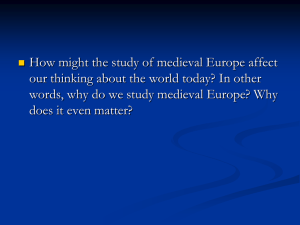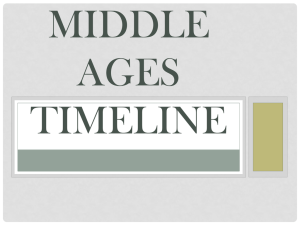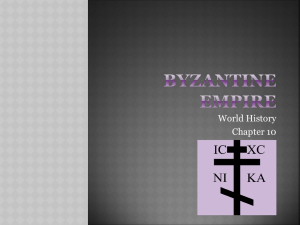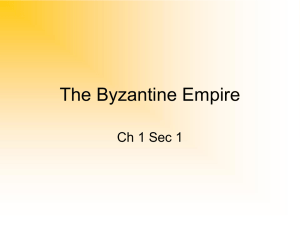Early Middle Ages
advertisement
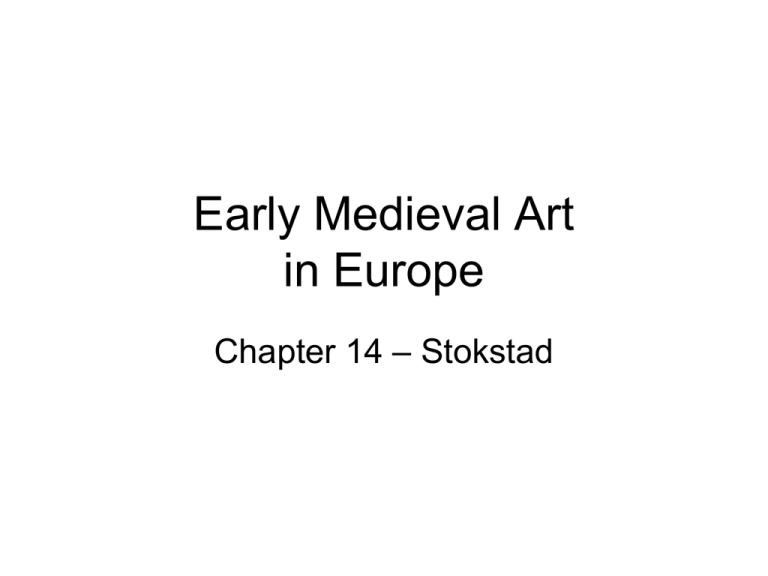
Early Medieval Art in Europe Chapter 14 – Stokstad The Middle Ages/ The Medieval Period • Designates Europe • During 1,000 years between fall of Western Roman Empire (5th century) and the Renaissance (15th century) • Divided into: Early Medieval Period (Chapter 14) Romanesque Period (Chapter 15) Gothic Period (Chapter 16) Early Medieval Period • 5th century Rome is no longer Imperial Capital (Constantine moved to Byzantium) • Upon Constantine’s death empire divided in two (between Constantine’s two sons) 1. Eastern Roman Empire = Byzantine Empire (Chapter 7) 2. Western Roman Empire • Emperor of the Western Roman becomes weak • Pope of Catholic Church takes some of responsibilities (pope amounts to governor of Rome) • Nomadic peoples enter and jockey for power in weakened Empire • Nomadic groups are called “barbarians” (meaning anyone outside the dominant influence) • Barbarians = Huns, Vandals, Visigoths, Celts, Vikings and Anglo-Saxons • Because nomadic: they create small, portable art The Vikings You are responsible for reading this section of the text on your own. Figures 14-9 and 14-10 Anglo-Saxon Period Sutton Hoo Burial Ship Redwald Byzantine Spoons French Coins Hinged Clasp • From Sutton Hoo burial ship • Suffolk, England • 7th century • Cloisonne and Millefiore • Interlace and Animal Interlace • Figure 14-4 Gold Buckle Medallion from Hanging Bowl • St. Patrick converts Ireland (the Celts) to Christianity in c. 400 CE • Roman monks continue converting “barbarians” to Christianity to the South • Irish monks begin converting other “barbarians” to Christianity to the North (i.e. England and Scotland) …their art becomes known as Hiberno-Saxon Hiberno-Saxon Period Illuminated Manuscripts “tools for conversion” • • • • • Display Script Page Initial Page Carpet Page Cross Carpet Page Evangelist Symbol Page Evangelist Symbols • • • • Matthew = man (winged) Mark = lion Luke = ox John = eagle Gospel Book of Durrow Page with Man • Gospel of Matthew from Gospel Book of Durrow • Iona, Scotland • 7th century • Ink and tempera paint on parchment • Figure 14-5 Carpet Page (Book of Durrow) Sometimes more ornate - Cross Carpet Page (as in Lindisfarne) Display Script Page (Book of Durrow) Chi Rho Iota Display Script Page • Gospel of Matthew begins with “Liber generationis”• The book of the generations of Christ (geneology) then it switches to narrative “Christi autem generatio” and begins the story of the birth of Christ Book of Kells Evangelist Symbols on Same Page Evangelist Portrait Page Display Script Page Chi Rho Iota Page (Initial Page) • Book of Kells (Book of Matthew) • Iona, Scotland • Late 8th or Early 9th century • Ink and pigment on vellum • Figure 14-1 • Much more elaborate… instead of just Display Script Page to mark the place in the Gospel of Matthew that begins the life of Christ, Book of Kells has 3 page spread… 1. Portrait of Christ 2. Cross Carpet Page 3. Chi Rho Iota Page (seen here) Carolingian Period c. 768 – 877 CE Carolingian Period • c. 800 CE the Vikings arrive in England and Ireland • Artistic production in the area plummets… • However, France and Germany are “holding their own” • Period (and area) dominated by figure of “Charlemagne the Great” Charlemagne -becomes King -because he protects pope and Christianity he is also crowned Emperor -because crowned Emperor, artistically he focuses on Imperial imagery (both Roman Imperial and Byzantine Imperial) Palace Chapel of Charlemagne Figure 14-14 Palace Chapel of Charlemagne • • • • • Interior view Aachen, Germany 792-805 Figure 14-13 Modeled after San Vitale (remember: Byzantine Emperor Justinian) Monastery Building Saint Gall Plan Fig 14-16 • Carolingian Period marked by great production in the arts, build up of monastic communities • However, at the end of this period…the Carolingians are attacked by several groups (including the Vikings) and lose their power. • The next group…The Ottonians…step into the void…they rule what had been the eastern half of the Carolingian Empire (present-day Germany) Ottonian Period c. 919 – 1002 CE Ottonian Period • Ottonians see themselves as the successors to the Carolingians (not as usurpers who take over during weakness of Carolingians) • They carry on tradition of Imperial association… • They take it a step further… Otto II marries Theophano, niece of the Byzantine Emperor (so, attempting to ally with most powerful Christian empire) Doors of Bishop Bernward • Abbey Church of Saint Michael • Hildesheim, Germany • 1015 • Bronze • Fig 14-24 Judgment (Adam and Eve vs. Christ by Pilate)




